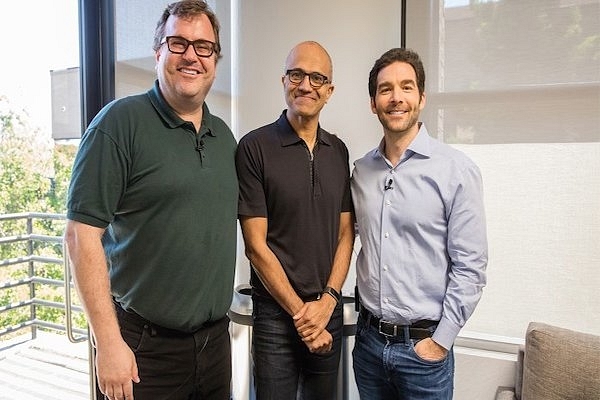
LinkedIn’s Acquisition By Microsoft: A B2B Marketer’s Road Map
Why has Microsoft paid a fortune to acquire LinkedIn?
Microsoft now owns your enterprise’s internal social graph, as well as the world’s professional social graph and a host of other data
The Marketing-Technology space or “martech”, as they call it, is still in its early days. When it comes to enhancing productivity, bettering processes or measuring, there are way too many tools in action. Connecting the dots- be it for ops, social selling or measurement & attribution- is difficult. Tools do not talk to each other, as marketers would want them to. Sometimes, it’s the way things are ‘architectured’ while sometimes it’s the lack of APIs or the exorbitant costs involved.
There are way too many tools and, thankfully, consolidation is happening to help build independent full stacks in martech. Adobe and Oracle have been, and still are, acquiring tools and apps to build a solid, go-to market strategy in this space.
Have a look at Microsoft- they acquired enterprise social networking tool Yammer in 2012 and it’s now part of its Office 365 suite. In 2013, they took over marketing automation tool MarketingPilot and integrated it into Dynamics CRM. Sometime later, they acquired NetBreeze to up the ante in social listening and analytics space. This again went into strengthening Dynamics CRM. So why did Microsoft pay a fortune to acquire LinkedIn? Here are some thoughts, based on my professional experience.
From a B2B marketers point of view, this deal is very promising- irrespective of the general sentiment around Microsoft’s ineptitude with post-acquisition integration. Imagine keeping track of a customer’s journey from the first touch point (a LinkedIn Sponsored Update, Text, Display Ad, InMail, Sales Navigator or the good old email) to nurturing the lead to closure, and beyond.
Albeit with a not-so-great market share, there is a Customer Relationship Managament (CRM) system that operates behind the scenes. LinkedIn Lead Accelerator (formerly Bizo but, currently, in a transition phase) “telling” the CRM who the visitor to your website is- irrespective of how he lands, be it from LinkedIn or from an email. Imagine integration with your CMS (Sharepoint/ Sharepoint Online, if I may say so) to personalize the user-experience on your website- based on data from LinkedIn, CRM and all your past interactions. That’s a killer combination, head-on against the Adobe stack and combined with a Demandbase and a compatible CRM.
But hey, chances are that the data to identify the customer precisely are more in the former. As a B2B marketer, I would rather trust LinkedIn in this case- as opposed to third-party providers like Dstillery, eXelate or Demandbase’s own WhoToo. To summarize, this acquisition gives one the hope of a full-funnel visibility for B2B marketers and social sellers.
Employee advocacy is a tough nut to crack- it’s just not easy to make employees become brand advocates of the employer’s social content. There are old players like GaggleAMP and then there are recent entrants like LinkedIn’s employee advocacy platform, Elevate. I believe that integrating LinkedIn’s Elevate with enterprise social network would be a killer combination.
Elevate was not the only time LinkedIn tried to get “into” your organization. LinkedIn came up with Lookup to help connect with your co-workers. Maybe it’s time to retire this, after adding onto Yammer whatever is missing. (This is a LinkedIn app I found “meh” and uninstalled within days. Frankly, didn’t find a point in having it on my phone). Facebook for Work, watch out!
LinkedIn sits on piles of data and they have been very conservative about sharing it- some of their interesting APIs have been retired or restricted.
For example, data from Company Pages can now be accessed only by Page Admins. No longer can you build a Competitor Dashboard that fetches data from half a dozen company pages, including your own. Unless, of course, you get into an agreement with LinkedIn- if at all they are ready to share that is. (There are tools like Quintly for this, but they rely on your competition signing up, a win-win model for brands). Or look at LinkedIn’s campaign management. There aren’t many tools in this space, possibly due to Linkedin’s clueless API road maps. Adstage, yes, but not the best tool a campaign manager can aspire for.
Hopefully, Microsoft would help LinkedIn scale the ecosystem around their data and APIs, thanks to Microsoft Azure’s Apiphany- the API management tool. From an API availability and integration standpoint, LinkedIn would be the lowest rung on the ladder (compared to say Twitter, YouTube etc. ).
With Microsoft coming in, hopefully LinkedIn search would become better. Another area that LinkedIn fails is app UI and UX- another point in my “Things Microsoft Should Look At” wishlist.
Then there are many low-hanging fruits like bringing in Office Online functionality within Pulse, like how they did on Yammer.
Pundits are writing about the possibilities of LinkedIn’s integration with Cortana- Microsoft’s digital assistant- and how Cortana is going to be made intelligent, even at the workplace. In fact, small steps in this direction were taken late last year.
These are things from a Marketer’s POV- from an HR business and recruitment angle, there are a dozen other things that this deal can usher in.
Think about it. Microsoft now owns your enterprise’s internal social graph, as well as the world’s professional social graph and a host of other data. I am extremely optimistic about the possibilities this deal can throw open.